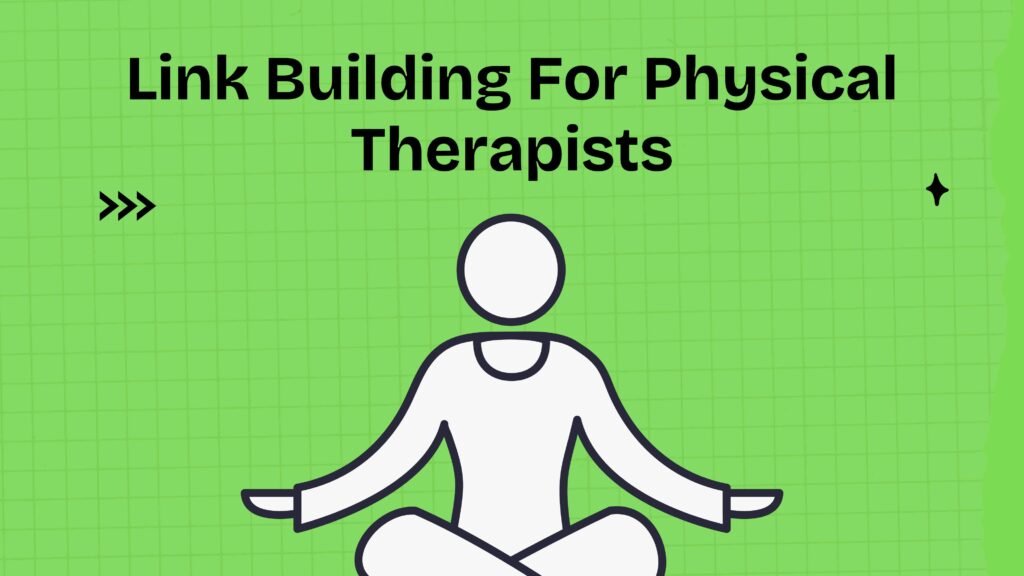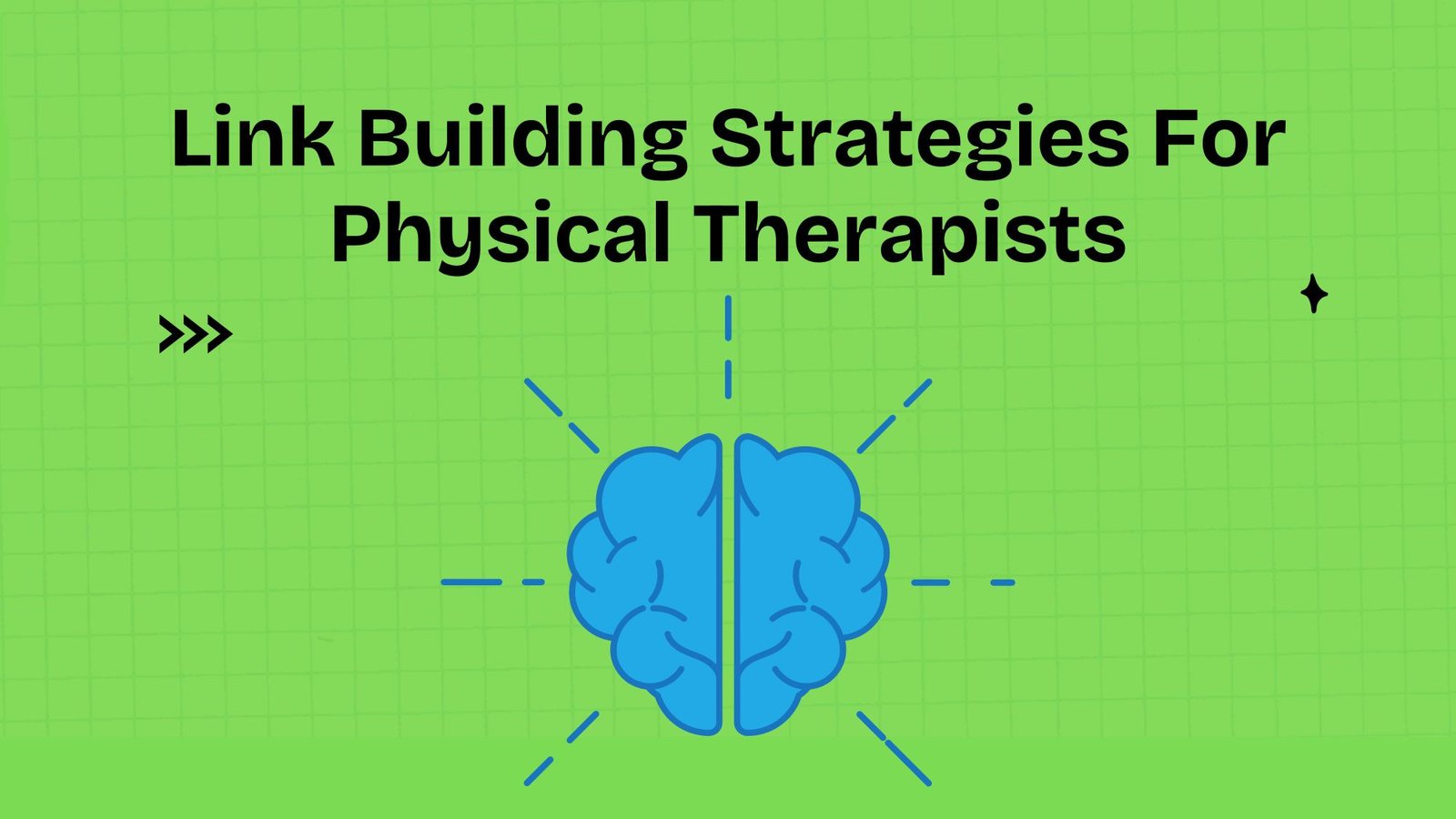
Link building is an essential component of digital marketing, especially for physical therapists looking to enhance their online presence and attract more patients. In today’s digital age, having a robust online presence is crucial for any business, and physical therapy practices are no exception. With the increasing reliance on search engines to find healthcare providers, ensuring that your practice appears prominently in search results can significantly impact your ability to reach potential patients. This is where link building comes into play.
Link building involves acquiring hyperlinks from other websites to your own, and it is a critical factor in how search engines like Google rank your site. For physical therapists, effective link building can lead to higher search engine rankings, increased website traffic, and ultimately, more patients walking through your doors. However, link building is not just about quantity; it’s about quality. High-quality, relevant links from reputable sources can enhance your site’s authority and credibility, making it more attractive to search engines and users alike.
For physical therapists, there are several strategies to consider when embarking on a link-building campaign. Collaborating with local healthcare providers, engaging with community organizations, and contributing to health-related blogs and forums are just a few ways to build valuable links. Additionally, creating informative and shareable content, such as blog posts, videos, and infographics, can naturally attract links from other sites interested in your expertise.
Moreover, understanding the nuances of link building, such as the importance of anchor text, the role of nofollow links, and the potential pitfalls of black-hat techniques, is crucial for success. By focusing on ethical and sustainable link-building practices, physical therapists can improve their online visibility and establish themselves as trusted authorities in their field.
In this article, we will delve deeper into the strategies and best practices for link building specifically tailored for physical therapists. Whether you’re new to digital marketing or looking to refine your existing efforts, this guide will provide you with the insights and tools needed to effectively enhance your online presence and grow your practice.
Why is Link Building For Physical Therapists Important?
Enhances Online Visibility
In today’s digital age, potential patients often search online for physical therapy services. Effective link building helps your website rank higher in search engine results, making it easier for prospective clients to find your practice. When your website appears on the first page of search results, it significantly increases the likelihood of attracting new patients.
Builds Authority and Credibility
Search engines view backlinks from reputable websites as votes of confidence. When authoritative health-related sites link to your practice, it signals to search engines that your website is trustworthy and valuable. This increased authority can lead to higher rankings and a stronger online reputation.
Drives Targeted Traffic
Quality backlinks from relevant sources, such as health blogs, local directories, or medical associations, attract visitors who are already interested in physical therapy services. This targeted traffic is more likely to convert into actual patients, increasing your practice’s growth and revenue.
Supports Local SEO Efforts
For physical therapists, local SEO is crucial. Link building with local directories, community websites, and regional health organizations helps improve your visibility within your geographic area. This local focus ensures that people searching for physical therapy services nearby are more likely to find your practice.
Cost-Effective Marketing Strategy
Compared to paid advertising, link building is a cost-effective way to boost your online presence. Once established, quality backlinks continue to generate traffic and authority without ongoing expenses. This makes it a sustainable long-term marketing strategy for physical therapists.
Improves Search Engine Rankings
Search engines like Google prioritize websites with strong backlink profiles. By actively engaging in link building, your website can climb higher in search results, leading to increased visibility and more patient inquiries.
Establishes Industry Relationships
Building backlinks often involves outreach to other healthcare providers, local businesses, and community organizations. These interactions can foster valuable relationships, collaborations, and referral networks that benefit your practice beyond just SEO.
Key Benefits Summary
- Increases online visibility and brand awareness
- Boosts website authority and trustworthiness
- Attracts targeted, local traffic
- Supports sustainable, long-term growth
- Enhances reputation within the healthcare community
For physical therapists aiming to grow their practice, investing in a strategic link building campaign is essential. It not only improves search engine rankings but also establishes your practice as a credible and trusted provider in your community. By focusing on quality backlinks from relevant and authoritative sources, you can attract more patients, increase your online presence, and ultimately, grow your practice sustainably.
Top Strategies For Link Building For Physical Therapists
 Effective link building is essential for physical therapists aiming to enhance their online visibility, attract new patients, and establish authority in the healthcare community. Implementing targeted strategies can significantly improve your website’s search engine rankings and drive more organic traffic. Below are some of the most proven tactics tailored specifically for physical therapy practices.
Effective link building is essential for physical therapists aiming to enhance their online visibility, attract new patients, and establish authority in the healthcare community. Implementing targeted strategies can significantly improve your website’s search engine rankings and drive more organic traffic. Below are some of the most proven tactics tailored specifically for physical therapy practices.
1. Create High-Quality, Relevant Content
Producing valuable content not only educates your audience but also encourages other websites to reference or link back to you.
- Blog Posts & Articles: Share insights on common injuries, recovery tips, or recent advancements in physiotherapy.
- Patient Success Stories: Showcase real-life case studies that highlight your expertise.
- Create Resources & Guides: Develop downloadable PDFs such as injury prevention checklists or exercise routines.
Tip:Incorporate keywords naturally within your content to boost SEO relevance while maintaining readability.
2. Build Relationships with Healthcare Professionals and Influencers
Networking within your industry opens doors to natural backlink opportunities.
- Partner with Physicians: Offer joint seminars, share referral resources, or co-author articles on interdisciplinary care. These collaborations often result in backlinks from other medical websites.
- Engage in Community Events: Sponsor health fairs, charity runs, or educational workshops. Such participation frequently earns local media coverage and backlinks.
3. Create Guest Posts and Run Outreach Campaigns
Guest blogging positions you as an expert and earns quality backlinks from reputable sites.
- Target the Right Sites: Focus on established healthcare blogs, wellness platforms, and local news outlets that align with your practice.
- Personalize Outreach: Craft compelling pitches explaining how your content will benefit their audience. Avoid generic requests—show genuine value.
- Be Consistent: Outreach is a long-term game. Use tools like BuzzStream or Hunter.io to manage contacts and follow up regularly.
4. Use Social Media Strategically
Social platforms are powerful tools for earning inbound links and boosting visibility.
- Share Blog Content: Post valuable articles and updates on platforms like Facebook, LinkedIn, and Twitter, always including direct links back to your site.
- Join Industry Groups: Engage in relevant professional communities online, offering insights that can lead to natural mentions and backlinks.
- Collaborate on Webinars or Live Sessions: Team up with influencers or other practitioners to create content that gets shared and linked by multiple sources.
Measuring & Analyzing Link Building Success
Simply getting backlinks isn’t enough—you need to track how they contribute to your goals.
Key Metrics to Monitor
- Domain Authority (DA) / Domain Rating (DR): Reflects the strength of sites linking to you.
- Number of Backlinks: Total links pointing to your site. More high-quality links generally mean better rankings.
- Referring Domains: The count of unique websites linking to you. A diverse link profile adds credibility.
- Anchor Text Distribution: Ensure anchor texts appear natural and relevant to avoid spam signals.
- Traffic from Referring Sites: Monitor visitors arriving via backlinks; high traffic indicates valuable link placements.
- Keyword Rankings: Track how your rankings for target keywords improve as your link profile grows.
- Conversion Rates: Check if increased visits translate into bookings or inquiries.
Tools to Track Performance
- Ahrefs: Detailed backlink profiles, DA scores, referring domains, and new/lost links.
- SEMrush: Keyword ranking reports tied to link-building efforts.
- Moz Pro: DA trends and spam score checks.
- Google Search Console: Free insights into how Google views your backlink profile.
Common Link-Building Mistakes to Avoid
1. Prioritizing Quantity Over Quality
Avoid seeking hundreds of low-value backlinks from irrelevant or spammy sites. Instead, focus on earning links from respected health websites, local directories, or industry blogs.
2. Ignoring Relevance
Links should come from sites relevant to your niche. Backlinks from unrelated industries do little for SEO and may appear unnatural. Prioritize connections with health-related sites, wellness blogs, sports organizations, or local community platforms.
3. Using Black Hat Techniques
Don’t buy links, join private blog networks (PBNs), or use shady schemes. These tactics risk penalties, harming your site’s visibility long-term.
4. Neglecting Local SEO
For location-specific practices, local backlinks are essential. Get cited on local directories, partner with neighborhood clinics, and contribute to community publications.
5. Failing to Audit Backlinks
Letting toxic links accumulate can damage your site’s reputation. Regularly audit your backlink profile using Ahrefs or SEMrush, and disavow harmful links.
FAQs
1.What is link building, and why is it important for physical therapists?
Link building is the process of acquiring hyperlinks from other websites to your own. These backlinks act as endorsements, helping search engines trust your site. For physical therapists, link building improves local search rankings, drives targeted traffic, and establishes authority within the healthcare community—ultimately bringing in more patients.
2. How can physical therapists find relevant websites for backlinks?
Focus on:
- Local directories (e.g., Google Business Profile, Yelp)
- Medical directories (e.g., Healthgrades, Zocdoc)
- Healthcare blogs and wellness platforms
- Local news websites and community pages
- Partner clinics, gyms, or sports organizations
You can also analyze competitors using SEO tools (like Ahrefs or SEMrush) to discover where they’re earning links.
3.Are paid backlinks or link schemes worth trying?
No. Purchasing links or joining link schemes violates Google’s guidelines and can lead to penalties—such as ranking drops or removal from search results. Always stick to ethical (white-hat) link-building strategies like creating valuable content, outreach, and partnerships.
4.How long does it take to see results from link building?
Link-building is a long-term strategy. You can expect noticeable improvements in search visibility and rankings within 3 to 6 months—depending on competition, link quality, and consistency of your efforts.
5.What types of backlinks provide the most value for physical therapists?
The best backlinks are:
✅ From authoritative, niche-relevant sites (e.g., health, fitness, wellness blogs)
✅ From local business or community directories
✅ Naturally embedded within content (rather than in footers or sidebars)
✅ From websites with good domain authority
6.Can link building help improve my Google Business Profile performance?
Yes! Quality backlinks—especially from local sources—can strengthen your local SEO, leading to better visibility in “near me” searches, higher Google Business Profile rankings, and more calls or inquiries.
7.How can I encourage patients to help with link building?
Ask satisfied patients to:
- Leave reviews on platforms like Google, Yelp, or Healthgrades
- Share your blog posts or social media updates
- Participate in testimonial videos or case studies that you publish on your site
8.What are the biggest mistakes to avoid in link building for physical therapists?
- Prioritizing quantity over quality
- Getting links from irrelevant or spammy websites
- Using black-hat tactics (buying links, joining link farms)
- Neglecting local SEO opportunities
- Failing to monitor and clean your backlink profile regularly
9.How do I monitor my backlink profile effectively?
Use SEO tools like:
- Ahrefs – to track new/lost backlinks, referring domains, and spam signals
- SEMrush – to connect backlinks with keyword ranking performance
- Moz Pro – for domain authority trends and spam score analysis
- Google Search Console – to view Google-recognized backlinks
- Regular audits help identify harmful links and new opportunities.
10. Can social media help with link building for my practice?
Absolutely! Sharing your blog posts, success stories, or event updates on platforms like Facebook, LinkedIn, and Twitter can attract organic backlinks and mentions. Engaging with relevant groups and collaborating on webinars also increases chances of earning valuable links.
Final Thoughts
By thoughtfully applying these link-building strategies, physical therapists can:
✅ Strengthen their local SEO presence
✅ Build lasting authority in their niche
✅ Attract more targeted patients
Regularly measure success, adapt your approach, and always prioritize ethical, high-value backlinks.
